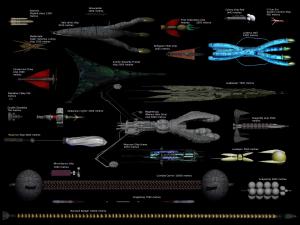BY LETTER
Grapeships
Culture and Society > Daily Life
Technology > Application > Transportation > Interstellar Transport
Technology > Application > Transportation > Ships
Technology > Application > Transportation > Interstellar Transport
Technology > Application > Transportation > Ships
 Image from Zatoon | |
| Grapeships consist of several spherical subunits (grapes) which can disassemble in order to pass through a wormhole, in order to reduce tidal stress on the contents. After passing through the throat of the wormhole they can then reassemble on the far side, and redeploy the reaction drive and radiator array. | |
Grapeships often travel along wormhole trunk-routes on a regular schedule. When they enter a system they often exchange a few grapes with other grapeships, and continue to the next wormhole.
Often a significant number of detached grapes will then attach to other, smaller grapeship stems and travel to local destinations within the system, or attach to large, powerful long-distance relativistic craft that will journey to other nearby stars with no wormhole connection.
Especially in systems controlled by transapients and archailects, grapeships (and individual grapes) can be collected by a reactionless-drive tug system known as the High Road, and this allows much faster transit times to its desination (wherever that may be). The High Road system accelerates the craft ship with no visible exhaust until it is hundreds of AU from the Throat and at the edge of the destination star system. At that point the High Road will release it with whatever momentum/velocity it had when it was picked up by the High Road and the ship can then accelerate via its internal drives for the rest of its journey.
This maximises throughput, and avoids having to dock at terminals in every system (often a slow process). Of course, delays and mishaps do occur, and many speak highly of the Negentropy Alliance where the grapeships always go on time.
 Image from Adam Getchell | |
| The regions of space within a Traversable Wormhole Note this diagram is not to scale; the Transition region extends for a distance of about 3 Astronomical units from the 'hole, while the Throat may be only a few tens of metres in radius. | |
 Image from Steve Bowers | |
| A Grapeship approaches the vortex of the traversable wormhole from Arkab Prior A to Medius | |
 | |
| Size comparison chart of spaceships used at various times in the Terragen Sphere (including a typical grapeship) | |
Related Articles
Appears in Topics
Development Notes
Text by Anders Sandberg
Additional material by Steve Bowers
Initially published on 31 October 2001.
Additional material by Steve Bowers
Initially published on 31 October 2001.







